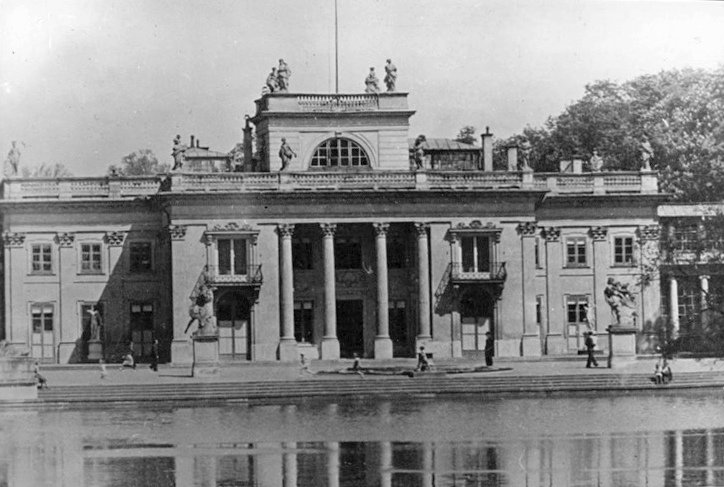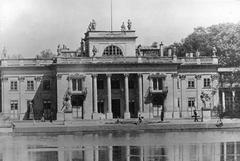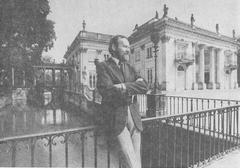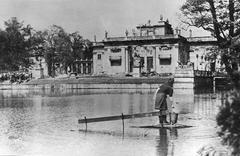
Łazienki Palace Visiting Hours, Tickets, and Comprehensive Guide to Warsaw’s Historical Jewel
Date: 14/06/2025
Introduction
Łazienki Palace, also known as the Palace on the Isle (Pałac na Wyspie), stands at the heart of Warsaw’s Royal Łazienki Park and is one of Poland’s most iconic historical and cultural landmarks. This neoclassical masterpiece, originally conceived as a royal bathhouse and transformed into a royal summer residence by King Stanisław August Poniatowski in the late 18th century, embodies Poland’s Enlightenment ideals, architectural grandeur, and resilience through centuries of political upheaval (SpottingHistory; Tourspilot). Today, Łazienki Palace and its surrounding park form a vibrant cultural center, hosting renowned open-air Chopin concerts, art exhibitions, and community events while welcoming millions of visitors each year.
This guide provides all the essential information on Łazienki Palace visiting hours, tickets and admission, accessibility, key attractions within the park, and practical tips to ensure you have a memorable and seamless visit. Whether you’re a history buff, architecture enthusiast, art lover, or simply seeking a peaceful retreat in the city, Łazienki Palace is a must-see Warsaw destination.
For the latest updates and official information, visit the Royal Łazienki Museum website.
Table of Contents
- Historical Overview
- Architectural and Cultural Significance
- Łazienki Palace Visiting Hours, Tickets, and Accessibility
- Highlights of the Visitor Experience
- Practical Travel Tips and Nearby Attractions
- Frequently Asked Questions (FAQ)
- Summary & References
Historical Overview
Origins and Early Development
The estate that would become Łazienki Palace began as a Baroque bathhouse and garden pavilion commissioned by Prince Stanisław Herakliusz Lubomirski in the late 17th century, situated in a vast hunting reserve once owned by the Dukes of Masovia. Dutch-born architect Tylman van Gameren created the original “Łazienka” (bathhouse), adorned with mythological motifs and serving as a place for leisure and contemplation (SpottingHistory; EveryCastle).
Enlightenment Transformation under King Stanisław August Poniatowski
In 1766, King Stanisław August Poniatowski acquired the estate and transformed it into a neoclassical palace and an intellectual hub for the Polish Enlightenment. Architects Domenico Merlini and Jan Chrystian Kamsetzer expanded the palace with elegant interiors, colonnades, and pavilions, drawing inspiration from European neoclassicism such as the Petit Trianon at Versailles. The king’s “Thursday Dinners” attracted luminaries in the arts and sciences, making Łazienki a focal point for progressive thought (Business Powerhouse).
The estate grew to include the White Pavilion, Myślewicki Palace, Old Orangery, Amphitheatre, and Chinese Pavilion—each contributing to the park’s architectural diversity and cultural vibrancy (EveryCastle).
19th Century and Russian Control
After Poland’s partitions and the abdication of King Stanisław August, Łazienki became part of the Russian-controlled territory. Despite changes in ownership, the estate retained its cultural significance, hosting museums, artists, and symbolic monuments such as the statues of Jan III Sobieski and, eventually, Fryderyk Chopin (Business Powerhouse).
Interwar Period and Presidential Residence
Following Poland’s independence in 1918, the estate served as the official summer residence of the President of the Republic and became accessible to the public. The 1923 unveiling of the Stanisław August equestrian statue underlined the palace’s symbolic link between Poland’s royal past and its modern national identity (Business Powerhouse).
World War II and Postwar Restoration
The Nazis looted and damaged the estate during World War II, but the main palace survived, albeit with significant losses. Postwar restoration efforts, including recent renovations, carefully preserved the estate’s historic features and reopened it as a museum and cultural venue (Wikipedia).
Today, Łazienki Palace remains a living symbol of Polish resilience, hosting millions of visitors and a wide array of cultural events (Business Powerhouse).
Architectural and Cultural Significance
Neoclassical Masterpiece
Łazienki Palace is one of Central Europe’s finest neoclassical structures, featuring harmonious proportions, Ionic columns, and interiors such as the Solomon Room and Ballroom that reflect the aesthetics of the Enlightenment (EveryCastle; Booked.ai). Its placement on an artificial island enhances its romantic, picturesque appeal.
Cultural Heart of Warsaw
Beyond its architecture, Łazienki Palace and Park have played a pivotal role in Polish intellectual and artistic life. The king’s Thursday Dinners, the vibrant collection of art and sculpture, and the continuous hosting of concerts and exhibitions all contribute to its status as a cultural hub (Tourspilot).
Symbolic Value
The palace’s survival and restoration through wars and partitions have made it a symbol of national pride and cultural endurance, while its public park setting ensures it remains a space for community gatherings, relaxation, and recreation (Booked.ai).
Łazienki Palace Visiting Hours, Tickets, and Accessibility
Park and Gardens
- Open daily: 6:00 AM – 10:00 PM
- Admission: Free (Łazienki Królewskie – Visiting)
- Note: Certain gates may be closed on Sundays and public holidays; check the official website for details.
Museum Buildings (Palace on the Isle, Old Orangery, etc.)
- April to October: 10:00 AM – 6:00 PM (last admission at 5:30 PM)
- November to March: 10:00 AM – 4:00 PM (last admission at 3:30 PM)
- Closed: Mondays, January 1, December 25
Tickets and Admission
- Combined Ticket (multiple buildings): 70 PLN (adult) / 35 PLN (reduced) / 1 PLN (children 7+, students under 26)
- Partial Ticket: 60 PLN (adult) / 30 PLN (reduced)
- Museum of Hunting and Horsemanship: 30 PLN (adult) / 15 PLN (reduced)
- Free Admission: Fridays for individual visitors (no reservations)
- Children under 7: Free
Tickets are purchased at onsite ticket offices; online sales are not available (Łazienki Królewskie – Visiting).
Group Bookings
For groups, reserve tickets in advance via [email protected] or (+48) 504 243 783.
Accessibility
- Wheelchair Access: Main park paths and most museum buildings are accessible, though some historic interiors may have limited access (Finding Poland).
- Restrooms: Available throughout the park.
- Service Animals: Permitted.
Getting There
- Public Transport: Bus lines 116, 180, 195 and several tram lines.
- By Car: Limited parking nearby; public transport is recommended.
- Central Location: Just 3.5 km from Warsaw’s Royal Castle (Polskieszlaki.pl).
Highlights of the Visitor Experience
- Palace on the Isle: The neoclassical centerpiece, renowned for its elegant interiors and lakeside views (Polska Bee).
- Old Orangery & Royal Theatre: Home to a unique 18th-century theatre and sculpture galleries (Finding Poland).
- Chopin Monument: Site of free open-air piano concerts every Sunday (May–September) at 12:00 and 16:00 (Łazienki Królewskie – Chopin Concerts).
- Gardens & Wildlife: Stroll through manicured gardens, past lakes, pavilions, and abundant wildlife including peacocks and red squirrels (Polska Bee).
- Seasonal Events: Attend art exhibitions, theatre performances, and festive winter illuminations (Warsaw Guide).
Practical Travel Tips and Nearby Attractions
- Best Time to Visit: Spring or autumn for vibrant gardens; weekday mornings for fewer crowds (Finding Poland).
- Photography: The palace’s lakeside reflection and the Chopin Monument are iconic photo spots.
- Amenities: Cafés, souvenir shops, and rest areas are located near major attractions.
- Transport: Use public transport for easy access; parking is limited.
- Nearby Sites: Ujazdowski Castle (modern art), Warsaw University Botanical Garden, Royal Route, and Warsaw Old Town (In Your Pocket; Official Warsaw Tourist Site).
Frequently Asked Questions (FAQ)
Q: What are Łazienki Palace’s visiting hours?
A: Palace buildings are open 10:00–18:00 (April–October), 10:00–16:00 (November–March); the park is open 6:00–22:00 daily.
Q: How do I buy tickets?
A: Purchase tickets at onsite ticket offices; online sales are not available.
Q: Is the park accessible for wheelchairs and strollers?
A: Yes, main paths are accessible, but some historic interiors may have limited access.
Q: Are there free events?
A: Yes, including open-air Chopin concerts every Sunday from May to September.
Q: Can I bring my pet?
A: No, pets are not allowed except service animals.
Q: Is the park suitable for children?
A: Absolutely—there are open spaces, wildlife, and educational exhibits for all ages.
Q: Are guided tours available?
A: Yes, in multiple languages; inquire at ticket offices.
Summary & References
Łazienki Palace is a testament to Poland’s royal history, Enlightenment spirit, and cultural vitality. Its harmonious blend of neoclassical architecture, lush gardens, and dynamic arts programming makes it an essential stop in Warsaw. Plan your visit by checking official opening hours, reviewing ticket options, and exploring guided tours or seasonal events through the Łazienki Królewskie website. With its accessible facilities and central location, Łazienki Palace promises a rewarding and memorable experience for every visitor.
References and Further Reading
- SpottingHistory
- Business Powerhouse
- EveryCastle
- Wikipedia
- Tourspilot
- Booked.ai
- Culture.pl
- Polskieszlaki.pl
- Epepa.eu
- Warsaw Guide
- Łazienki Królewskie – Visiting
- Polska Bee
- Finding Poland
- In Your Pocket
For more travel tips, download the Audiala app and follow us on social media for updates on Łazienki Palace and Warsaw’s cultural scene.



































































































































































